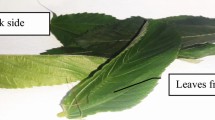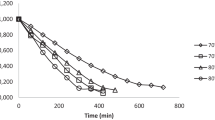Abstract
The effect of drying conditions on the color of tarragon (Artemisia dracunculus L.) leaves was studied. Tarragon leaves were dried at temperatures of 40 to 90 °C with a constant airflow of 0.6 m/s. The samples were collected at 7%, 10%, 20%, and 30% moisture content wet basis for evaluation of the color change. The color parameters of fresh and dried leaves were measured by a colorimeter. The individual parameters of L*a*b* and L*C*h° color systems were evaluated and h° proved to be the best parameter to monitor color change. The smallest change of the color parameters was observed at 40 °C, in which temperature was low, and also at 90 °C, when drying time was short. The biggest change occurred at the temperatures of 50 to 70 °C. Most of the color change happened before the material reaches 35% moisture content. The combination of drying time and temperature defines the change of color.








Similar content being viewed by others
References
Ahmed, J., Kaur, A., & Shivhare, U. (2002). Color degradation kinetics of spinach, mustard leaves, and mixed puree. Journal of Food Science, 67(3), 1088–1091.
Arabhosseini, A., Huisman, W., van Boxtel, A., & Mueller, J. (2005). Sorption isotherms of tarragon (Artemisia dracunculus L.) [Sorptionsisothermen von Estragon (Artemisia dracunculus L.)]. Zeitschrift für Arznei- und Gewürzpflanzen, 11(1), 48–51.
Arabhosseini, A., Huisman, W., van Boxtel, A., & Mueller, J. (2008). Modeling of thin layer drying of tarragon (Artemisia dracunculus L.). Industrial Crops and Products, 28(2), 53–59.
Berberich, J., Dee, K. H., Hayauchi, Y., & Portner, C. (2002). A new method to determine discoloration kinetics of uncoated white tablets occurring during stability testing—An application of instrumental color measurement in the development pharmaceutics. International Journal of Pharmaceutic, 234(1–2), 55–66.
Carreno, J., Martinez, A., Almela, L., & Fernandez-Lopez, J. A. (1995). Proposal of an index for the objective evaluation of the colour of red table grapes. Food Research International, 28(4), 373–377.
Commission Internationale de l’Eclairage. (1986). Colorimetry (2nd ed). Vienna, Austria: CIE Publication No. 15.2.
Du Toit, J., & Joubert, E. (1998). Effect of drying conditions on the quality of honeybush tea (Cyclopia). Journal of Food Processing and Preservation, 22(6), 493–507.
Ganjloo, A., Rahman, R. A., Osman, A., Baker, J., & Bimakr, M. (2009). Kinetics of crude peroxidase inactivation and color changes of thermally treated seedless Guava (Psidium guajava L.). Food and Bioprocess Technology, doi:10.1007/s11947-009-0245-4.
García-Esteban, M., Ansorena, D., Gimeno, O., & Astiasarán, I. (2003). Optimization of instrumental colour analysis in dry-cured ham. Meat Science, 63(3), 287–292.
Guine, R. P. F., Henrriques, F., & Barroca, M. J. (2009). Mass transfer coefficients for the drying of pumpkin (cucurbita moschata) and dried product quality. Food and Bioprocess Technology, doi:10.1007/s11947-009-0245-4.
Iwe, M. O., Van Zuilichem, D. J., & Ngoddy, P. O. (2000). Color of single-screw extruded blends of soy-sweet potato flour—A response surface analysis. Plant Foods for Human Nutrition, 55(2), 159–168.
Krokida, M. K., Tsami, E., & Maroulis, Z. B. (1998). Kinetics on color changes during drying of some fruits and vegetables. Drying Technology, 16(3–5), 667–685.
Lee, H. S., Coates, G. A., & Lee, H. S. (2003). Effect of thermal pasteurization on Valencia orange juice color and pigments. Food Science and Technology, 36(1), 153–156.
Lozano, J. E., & Ibarz, A. (1997). Colour changes in concentrated fruit pulp during heating at high temperatures. Journal of Food Engineering, 31(3), 365–373.
Maharaj, V., & Sankat, C. K. (1996). Quality changes in dehydrated dasheen leaves: Effects of blanching pre-treatments and drying conditions. Food Research International, 29(5–6), 563–568.
Maskan, M. (2001). Kinetics of colour change of kiwifruits during hot air and microwave drying. Journal of Food Engineering, 48(2), 169–175.
McCaig, T. N. (2002). Extending the use of visible/near-infrared reflectance spectrophotometers to measure colour of food and agricultural products. Food Research International, 35(8), 731–736.
Patras, A., Brunton, N. P., Tiwari, B. K., & Butler, F. (2009). Stability and degradation kinetics of bioactive compounds and colour in strawberry jam during storage. Food and Bioprocess Technology, doi:10.1007/s11947-009-0226-7.
Shin, S., & Bhowmik, S. R. (1995). Thermal kinetics of color changes in pea puree. Journal of Food Engineering, 24(1), 77–86.
Silva, F. M., & Silva, C. L. M. (1999). Colour changes in thermally processed cupuaçu (Theobroma grandiflorum) puree: Critical times and kinetics modelling. International Journal of Food Science and Technology, 34(1), 87–94.
Simon, J. E., Chadwick, A. F., & Craker, L. E. (1984). Herbs: An indexed bibliography, 1971–1980: The scientific literature on selected herbs and aromatic and medicinal plants of the temperate zone. Amsterdam: Elsevier.
Suh, H. J., Noh, D. O., Kang, C. S., Kim, J. M., & Lee, S. W. (2003). Thermal kinetics of color degradation of mulberry fruit extract. Die Nahrung, 47(2), 132–135.
Vienne, M., Braemer, R., Paris, M., & Couderc, H. (1989). Chemotaxonomic study of two cultivars of Artemisia dracunculus L.: (“French” and “Russian” Tarragon). Biochemical Systematics and Ecology, 17(5), 373–374.
Yaichibe, T., Masanori, K., & Kenichi, A. (1997). Morphological characters and essential oil in Artemisia dracunculus (French Tarragon) and Artemisia dracuncloides (Russian Tarragon). Tokyo Nogyo Daigaku Nogaku Shuho, 41(4), 229–238.
Zhang, M., De Baerdemaeker, J., & Schrevens, E. (2003). Effects of different varieties and shelf storage conditions of chicory on deteriorative color changes using digital image processing and analysis. Food Research International, 36(7), 669–676.
Acknowledgment
Financial support from Aboureyhan Campus, Tehran University, Ministry of Science, Research and Technology of Iran is gratefully acknowledged.
Author information
Authors and Affiliations
Corresponding author
Rights and permissions
About this article
Cite this article
Arabhosseini, A., Padhye, S., Huisman, W. et al. Effect of Drying on the Color of Tarragon (Artemisia dracunculus L.) Leaves. Food Bioprocess Technol 4, 1281–1287 (2011). https://doi.org/10.1007/s11947-009-0305-9
Received:
Accepted:
Published:
Issue Date:
DOI: https://doi.org/10.1007/s11947-009-0305-9




